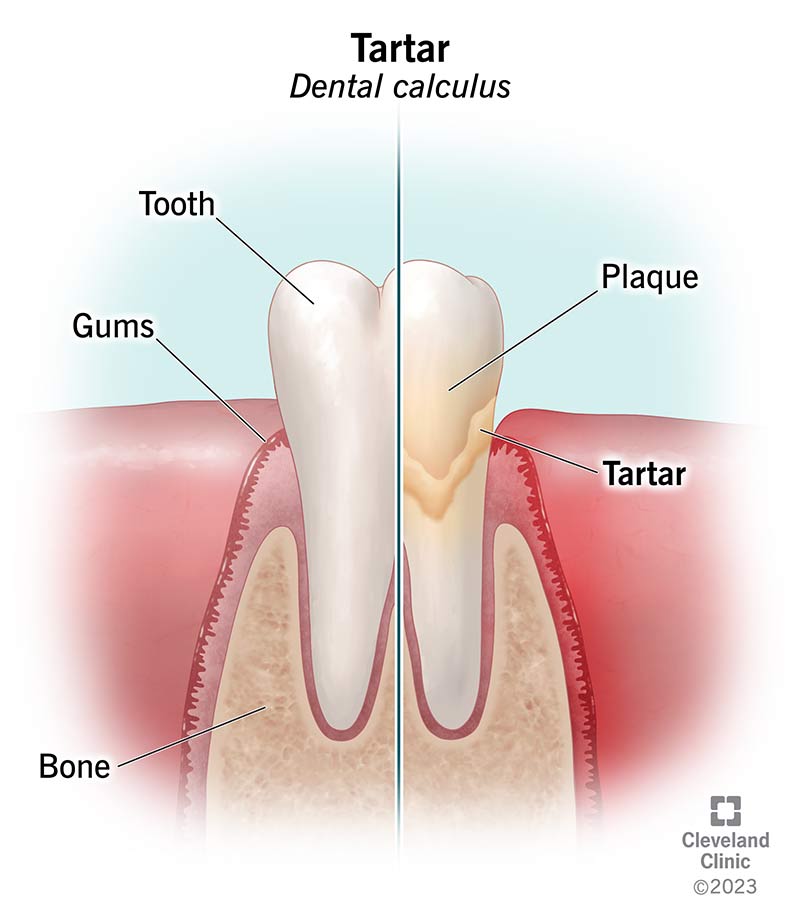Tartar is hardened dental plaque. Without proper oral hygiene, tartar can build up on your teeth and lead to gum disease and other oral health issues. Only a dentist or hygienist can remove tartar. You can’t remove it with brushing and flossing alone.
Advertisement
Cleveland Clinic is a non-profit academic medical center. Advertising on our site helps support our mission. We do not endorse non-Cleveland Clinic products or services. Policy

Tartar is hardened dental plaque that can form on your teeth, both above and below your gum line. Everybody gets plaque. But unless you remove it with proper oral hygiene, plaque can harden into tartar.
Advertisement
Cleveland Clinic is a non-profit academic medical center. Advertising on our site helps support our mission. We do not endorse non-Cleveland Clinic products or services. Policy
Unlike plaque, you can’t remove tartar with brushing and flossing. A dentist or dental hygienist must remove it during a professional dental cleaning.
Another name for tartar is dental calculus.
Tartar mostly contains dead bacteria that have mineralized, mixed with a small amount of mineralized proteins from your saliva (spit).
Specifically, tartar consists of these minerals:
If you start to develop tartar on your teeth, you might notice:
Yes, tartar usually has an unpleasant odor. It can also cause small pockets to form in the areas between your teeth and gums. Bacteria and food debris can get trapped there, resulting in bad breath or a bad taste in your mouth.
When you don’t routinely remove plaque from your teeth, it can turn into tartar. So, tartar is usually a result of poor oral hygiene.
You’re more likely to develop plaque and tartar if you:
Advertisement
If you don’t remove tartar from your teeth, you’re much more likely to develop:
A dentist can tell you whether you have tartar buildup during a routine dental examination. If they suspect you have cavities, gum disease or other issues as a result, they may also:
The only way to effectively treat tartar is to see a dentist or hygienist. They’ll remove the tartar safely using a combination of special instruments.
It might be tempting to remove tartar from your teeth without a dentist, but this can actually damage your teeth and make you more susceptible to cavities and other issues.
Depending on the amount of tartar buildup you have, your dentist may recommend:
Routine dental cleanings are the best way to keep your mouth and teeth healthy. During a cleaning, a dental hygienist removes plaque and tartar from your teeth using special instruments. They’ll also thoroughly floss between your teeth and polish your teeth surfaces using a rubber cup and gritty toothpaste.
Many people can keep tartar at bay with cleanings every six months. But if you’re prone to cavities, gum disease or other issues, you might need cleanings more often. Ask your dentist what cleaning schedule is right for you.
If tartar has already caused some bone loss around your teeth, your dentist may recommend gum disease treatment. These procedures remove tartar that’s trapped beneath your gum line, where brushing and flossing can’t reach.
Common gum disease treatments include:
To avoid issues like cavities and gum disease, it’s best to stop tartar from forming in the first place. To help prevent tartar buildup on your teeth:
Advertisement
It depends on your unique oral health needs. Some people build up plaque and tartar faster than others. Most people need cleanings every six months. But you might need them more often if you’re prone to issues like tooth decay and gum disease. Ask your dentist what type of maintenance schedule is right for you.
Dental plaque is a yellowish, sticky film. It develops when bacteria in your mouth feed on sugars in the foods you eat. Plaque feels “fuzzy” on your teeth, but you can remove it with brushing and flossing.
Tartar is hardened plaque. It might be yellowish at first, but it can turn darker over time. Tartar feels like a hard shell on your teeth. Unlike plaque, you can’t remove tartar with brushing and flossing.
Occasionally, tartar can break off your teeth when you’re eating certain foods or brushing too aggressively. When this happens, it can leave a rough or sharp area behind. It might be tempting to remove more tartar on your own. But doing this can damage your teeth and gums.
Call your dentist if you notice tartar breaking off your teeth. They can remove the remaining tartar safely and effectively.
Tartar takes on the color of whatever foods and drinks you consume. You might notice black tartar if you:
Advertisement
Tartar beneath your gum line can also cause bleeding. When blood mixes with tartar, it can turn black.
The best way to prevent tartar is to practice good oral hygiene. But sometimes, tartar can form despite your best efforts. If this happens, schedule a visit with a dentist right away. While tartar buildup isn’t an emergency, it’s best to remove it as soon as possible to avoid issues like cavities and gum disease.
Advertisement
Dentistry plays an important role in oral health. Cleveland Clinic’s experts can design a personalized plan that will keep you smiling for the long haul.

Last reviewed on 06/19/2023.
Learn more about the Health Library and our editorial process.